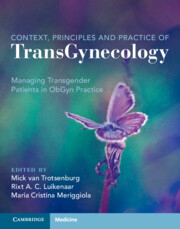Book contents
- Context, Principles, and Practice of Transgynecology
- Context, Principles, and Practice of Transgynecology
- Copyright page
- Dedication
- Contents
- Foreword
- Preface
- Contributors
- Abbreviations
- Section A Contextual Transgynecology
- Chapter 1 Terminology in Transgender Medicine
- Chapter 2 Optimizing Clinical Ob/Gyn Services through Improved Communication with Trans Persons
- Chapter 3 What Do Trans People Expect from Transition and What Do They Encounter Physically?
- Chapter 4 A Pondering Trans Female Gynecologist
- Chapter 5 The Ever-changing Role of the Mental Health Care Professional in Transgender Healthcare
- Chapter 6 Impact of Stigma and Resilience on the Health of Transgender and Nonbinary People
- Chapter 7 Dealing with Health Needs and Physical Complaints of Nonbinary Clients
- Chapter 8 Gender is So Much More: Impulses for a Gender-variant Gynecological Expertise from a Queer-theoretical Perspective
- Section B Practicing Transgynecology
- Section C Gynecological Surgery for Transgender Males
- Section D Sexuality and Contraception
- Section E Fertility and Reproduction
- Section F Impact of Gender-affirming Hormonal Therapy on Genital Organs
- Section G Screening and Prophylaxis
- Transgynecology Index
- References
Chapter 2 - Optimizing Clinical Ob/Gyn Services through Improved Communication with Trans Persons
from Section A - Contextual Transgynecology
Published online by Cambridge University Press: 22 December 2022
- Context, Principles, and Practice of Transgynecology
- Context, Principles, and Practice of Transgynecology
- Copyright page
- Dedication
- Contents
- Foreword
- Preface
- Contributors
- Abbreviations
- Section A Contextual Transgynecology
- Chapter 1 Terminology in Transgender Medicine
- Chapter 2 Optimizing Clinical Ob/Gyn Services through Improved Communication with Trans Persons
- Chapter 3 What Do Trans People Expect from Transition and What Do They Encounter Physically?
- Chapter 4 A Pondering Trans Female Gynecologist
- Chapter 5 The Ever-changing Role of the Mental Health Care Professional in Transgender Healthcare
- Chapter 6 Impact of Stigma and Resilience on the Health of Transgender and Nonbinary People
- Chapter 7 Dealing with Health Needs and Physical Complaints of Nonbinary Clients
- Chapter 8 Gender is So Much More: Impulses for a Gender-variant Gynecological Expertise from a Queer-theoretical Perspective
- Section B Practicing Transgynecology
- Section C Gynecological Surgery for Transgender Males
- Section D Sexuality and Contraception
- Section E Fertility and Reproduction
- Section F Impact of Gender-affirming Hormonal Therapy on Genital Organs
- Section G Screening and Prophylaxis
- Transgynecology Index
- References
Summary
Care for trans and gender nonconforming individuals will become a substantial part of Ob/Gyn practice. However, at present, many Ob/Gyn professionals experience insufficient knowledge and skills to accommodate this group. In this chapter, four key principles will be described to improve clinical services for this group. Key to this is a gender-affirmative approach and a sensitive stand by healthcare professionals, as well as a willingness to assess one’s own assumptions and knowledge (gaps). Also, one is encouraged to openly interact with local trans communities to design clinical services with a welcoming environment and low barriers to care, and to engage individuals in shared decision-making.
Keywords
Information
- Type
- Chapter
- Information
- Context, Principles and Practice of TransGynecologyManaging Transgender Patients in ObGyn Practice, pp. 9 - 18Publisher: Cambridge University PressPrint publication year: 2022
